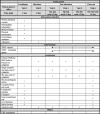Xue-Fu-Zhu-Yu capsule in the treatment of qi stagnation and blood stasis syndrome: a study protocol for a randomised controlled pilot and feasibility trial
- PMID: 30241562
- PMCID: PMC6151047
- DOI: 10.1186/s13063-018-2908-9
Xue-Fu-Zhu-Yu capsule in the treatment of qi stagnation and blood stasis syndrome: a study protocol for a randomised controlled pilot and feasibility trial
Abstract
Background: Qi stagnation and blood stasis syndrome (QS&BSS) is one of the common Zhengs in traditional Chinese medicine (TCM), which manifests as various symptoms and signs, such as distending pain or a tingling sensation in a fixed position. In recent years, a number of clinical trials have focused on the effectiveness and safety of XFZYC in patients with a QS&BSS subtype disease, such as coronary heart disease, hyperlipidaemia, ischaemic cerebrovascular disease, gastritis, dysmenorrhoea, or arthritis, in terms of the outcomes of relevant diseases. However, there is lack of evidence of the effects of XFZYC in patients with QS&BSS with different diseases, focusing on the outcomes of Zhengs.
Methods/design: A randomised, controlled, pilot and feasibility trial will be employed in this study, using a 7-week study period. Participants will be recruited from Guang'anmen Hospital, Huguosi TCM Hospital, Wangjing Hospital in China. One hundred and twenty participants will be randomised to a treatment group (Xue-Fu-Zhu-Yu Capsule (XFZYC)) and placebo group in a 1:1 ratio. Participants included in the study must be diagnosed with Qi stagnation and blood stasis syndrome criteria. The outcome measurements will include the traditional Chinese medicine patient-reported outcome (PRO) scale for QS&BSS, the single symptom and sign scale of QS&BSS, and the pain scale of QS&BSS. The clinical data management system ( http://www.tcmcec.net /) will be used to collect and manage the data. Quality control will be used, according to Good Clinical Practice (GCP).
Discussion: Previous studies were expected to evaluate whether the addition of XFZYC to standard routine treatment would enhance the treatment effectiveness and improve the biomedical parameters pertaining to relevant disease. However, this trial is focused on the outcome of Zhengs, and we chose a range of outcome measurements to assess the improvement of relevant symptoms and signs. This trial is the first study designed to define and optimise the outcome measurements of Zhengs of XFZYC in the treatment of patients with QS&BSS.
Trial registration: ClinicalTrials.gov, NCT03091634 . Registered on 12 August 2018. Release date 6 May 2017.
Keywords: Chinese medicine; Qi stagnation and blood stasis syndrome; Randomised clinical trial; Xue-Fu-Zhu-Yu capsule.
Conflict of interest statement
Ethics approval and consent to participate
The final revised version of the protocol, informed consent and recruitment poster of this trial have been reviewed and approved by Ethics Committee of Guang’anmen Hospital of China Academy of Chinese Medical Sciences (No. 2017-043-ky-01). Written informed consent must be obtained from each participant before enrolment.
Consent for publication
Not applicable.
Competing interests
The authors declare that they have no competing interests.
Publisher’s Note
Springer Nature remains neutral with regard to jurisdictional claims in published maps and institutional affiliations.
Figures
References
-
- Chan M, Leshner A, Fan TP, et al. “The art and science of traditional medicine part 1: TCM today - a case for integration” Produced by the Science/AAAS Custom Publishing Office Sponsored by Contents. Science. 2014;346(6216 Suppl):S1–S25.
-
- Cheng CW, Wu TX, Shang HC, et al. CONSORT extension for Chinese herbal medicine formulas 2017: recommendations, explanation, and elaboration. Ann Intern Med. 2017. 10.7326/IsTranslatedFrom_M17-2977_1. - PubMed
-
- Chen BH, Shen CY, Su Z. Xuefu Zhuyu capsule for ischemic cerebrovascular disease in 126 cases. World Chinese Med. 2011;6(04):334.
Publication types
MeSH terms
Substances
Associated data
Grants and funding
LinkOut - more resources
Full Text Sources
Other Literature Sources
Medical


